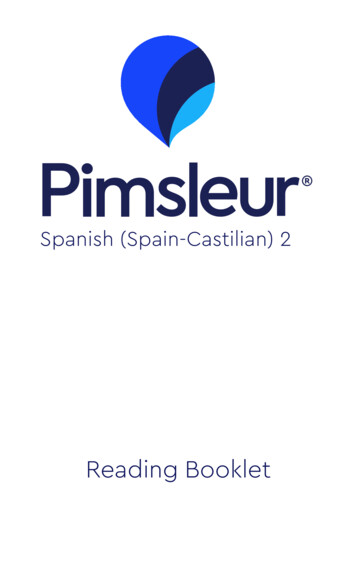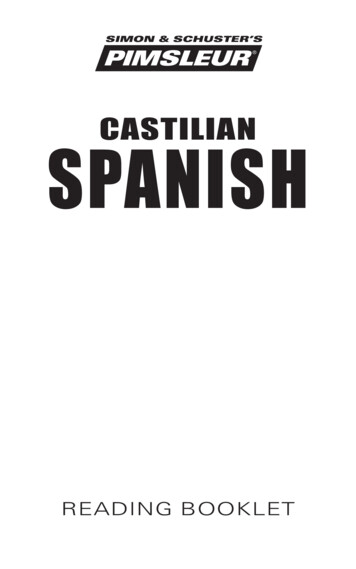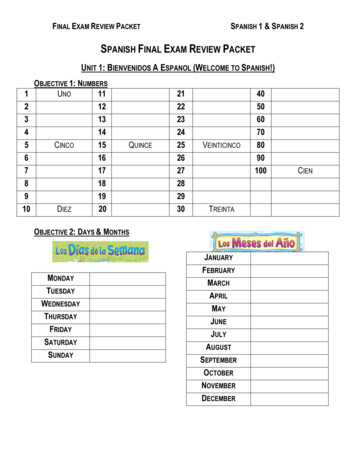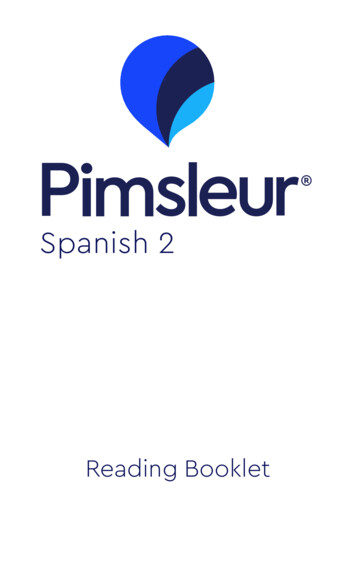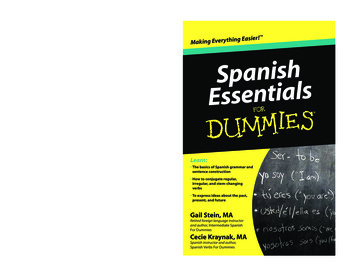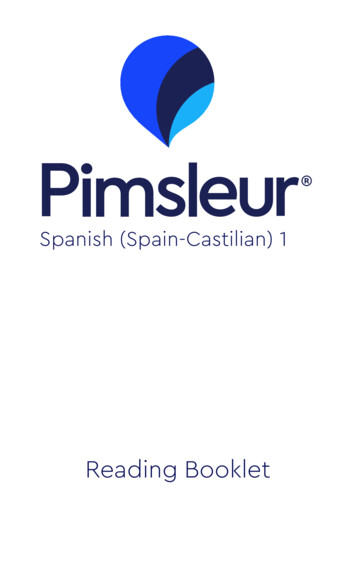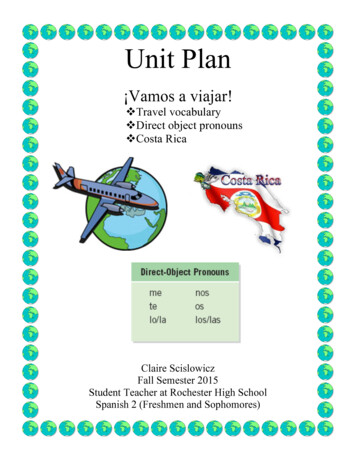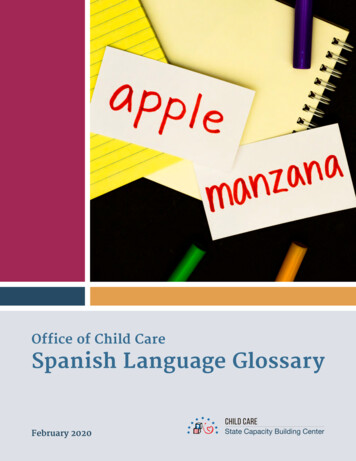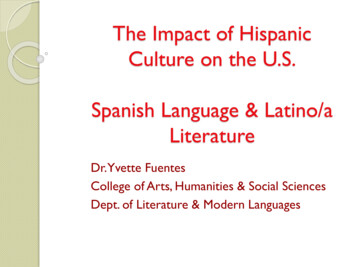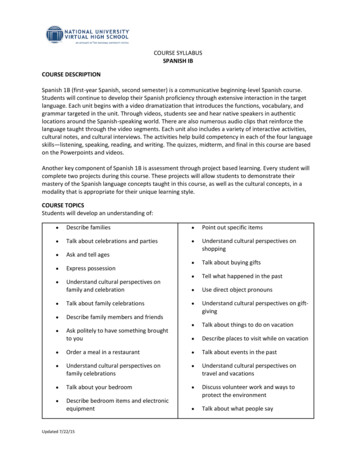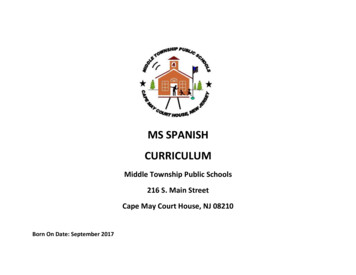
Transcription
MS SPANISHCURRICULUMMiddle Township Public Schools216 S. Main StreetCape May Court House, NJ 08210Born On Date: September 2017
ContentsAcknowledgements. 2Introduction to Spanish . 3Course Description. 36th Grade - . 37th Grade - . 38th Grade - . 4Grade 6. 5Unit Plan: Greetings and Small Talk . 5Unit Plan: Describing the Classroom . 13Unit Plan: Describing People and Things . 20Unit Plan: Mexican Holidays and Celebrations . 27Grade 7. 35Unit Plan: Greetings and Small Talk . 35Unit Plan: Describing the Classroom . 43Unit Plan: Family and Personal Descriptions . 51Unit Plan: Mexican Holidays and Celebrations . 59Unit Plan: Clothing and the Home . 67Grade 8. 751 Page
Unit Plan: Greetings and Small Talk . 75Unit Plan: Describing the Classroom . 83Unit Plan: Family and Personal Descriptions . 91Unit Plan: Mexican Holidays and Celebrations . 99Unit Plan: Clothing and the Home . 107Unit Plan: Transportation and the Spanish-Speaking World . 114New Jersey Student Learning Standard for World Languages . 121Spanish Curriculum Map . 130AcknowledgementsDr. David Salvo-SuperintendentKathleen McDonald-Director of Curriculum and InstructionDr. Toni Lehman- PrincipalMiddle School Math Curriculum CommitteeSteve Collins2 Page
Middle Township Middle SchoolSpanishIntroduction to SpanishThis is a 3 year, exploratory Spanish program for middle school grades 6, 7 & 8. Each year will include a 36 day semester and willfocus on the 3 modes of communication: interpretive, interpersonal and presentational. The proficiency level of the students isexpected to be novice-mid on the ACTFL scale. Implementation of this program will provide an introduction to the Spanish languageand better prepare students for the high school sequence. Students will learn various thematic units, use basic vocabulary and phrasesand interact in limited social situations. In addition, students will develop an awareness of the distinct cultures, traditions andcelebrations of the Spanish-speaking world. Students interested in continuing their study of Spanish upon completion of this programwill enroll in Spanish 1.Course Description6th Grade - This class will be the first in the middle school sequence of Spanish courses. The class will last 45 days and will focus onthe three modes of communication: interpretive, interpersonal, and presentational. The proficiency level of the students at this level isexpected to be novice-mid on the ACTFL scale. By implementing this course, we will be better preparing students for the high schoolsequence of world languages courses, as well as allowing them more opportunities to gain language proficiency.7th Grade - This class will be the second course in the middle school sequence of Spanish courses. The class will last 45 days andwill focus on the three modes of communication: interpretive, interpersonal, and presentational. The proficiency level of the studentsat this level is expected to be novice-mid on the ACTFL scale. By implementing this course, we will be better preparing students forthe high school sequence of world languages courses, as well as allowing them more opportunities to gain language proficiency.3 Page
8th Grade - Introduction to Spanish is a basic Spanish course. It is available to all students seeking to fulfill their graduationrequirement and obtain a gentle introduction to the Spanish-speaking world. In this course, students will learn to use basic phrases,describe people, places and things, and interact in limited social situations. In addition, students will also develop an awareness of thecultures within the twenty Spanish-speaking countries of the world. Students interested in continuing their study of Spanish uponsuccessful completion of Introduction to Spanish will enroll in Spanish I.4 Page
Grade 6Unit Plan: Greetings and Small TalkContent Area:SpanishUnit Plan Title:Greetings and Small TalkGrade(s) 6Target Proficiency LevelNoviceOverview/RationaleBeginning Spanish speakers must begin to feel comfortable expressing themselves and responding to others in everyday situations. They need toknow some basic vocabulary and be able to apply it in conversation. This unit will deal with some of the most common topics of everydayconversations: meeting others, introducing oneself, exchanging pleasantries, stating the day and date and inquiring about the time and weather.Standard(s) (Established Goals) and Strand(s)7.1.NH.A.1 Interpretive - Recognize familiar works and phrases, understand the main idea and infer the meaning of some highly contextualized,unfamiliar spoken or written words contained in culturally authentic materials using electronic information sources related to targeted themes.7.1.NH.A.3 Interpretive – Recognize some common gestures and practices of the target culture7.1.NH.A5 Interpretive/interpersonal Demonstrate comprehension of short conversations and brief written messages on familiar topics.7.1.NH.B4 Interpersonal Ask and respond to questions, make requests and express preferences in various social situations.5 Page
Technology Standard(s)8.1.P.C.1 Collaborate with peers by participating in interactive digital games or activities.8.1.8.A.4 Graph and calculate data within a spreadsheet and present a summary of results.Interdisciplinary Standard(s)NJSLSA.R2 Determine central ideas or themes of a text and analyze their development; summarize the key supporting details and ideas.NJSLSA.R4 Interpret words and phrases as they are used in a text, including determining technical, connotative and figurative meanings andanalyze how specific word choices shape meaning or tone.RST.6-8.9 Compare and contrast the information gained from experiments, simulations, video or multimedia sources with that gained fromreading a text on the same topic.NJSLSA.W4 Produce clear and coherent writing in which the development, organization and style are appropriate to task, purpose and audience.Enduring Understandings: (What are the big ideas? What specific understandings about them are desired? What misunderstandingspredictable?)Students will understand how to greet someone, how to introduce themselves and ask and respond to routine questions. They will be able toask/answer questions about the time and the weather and express the day and date.It is desired that students feel comfortable with routine, repetitive phrases that are easily recognized without significant delay or thought.6 Pageare
It is predicted that students will confuse questions and responses without significant repetition, time and practice. Continued review and revisiting of these themes in subsequent lessons should strengthen and improve understanding and ability.Essential Question(s): (What provocative questions will foster inquiry, understanding, and transfer of learning?)How do Spanish speakers make initial conversation?How do we express the time in Spanish?How do we count and use numbers in Spanish?How do we express the weather in Spanish?How do we express the day and date in Spanish?In this unit plan, the following 21st Century themes and skills are addressed:Indicate whether these skills are E-Encouraged, T-Taught, or A-Assessed in this unit by marking E, T,A on the line before the appropriate skill.Check all that apply.21stCentury ThemesX21 s t Century SkillsGlobal AwarenessCritical Thinking & Problem SolvingEnvironmental LiteracyECreativity and InnovationHealth LiteracyACollaboration, Teamwork and LeadershipCivic LiteracyTCross-Cultural and Interpersonal Communication7 Page
Financial, Economic, Business andEntrepreneurial LiteracyACommunication and Media FluencyAccountability, Productivity and EthicsIn this unit plan, the following Career Ready Practices are addressed:Indicate whether these skills are E-Encouraged, T-Taught, or A-Assessed in this unit by marking E, T, A on the line before the appropriate skill.CRP1. Act as a responsible and contributing citizen and employeeACRP2. Apply appropriate academic and technical skillsCRP3. Attend to personal health and financial well-beingTCRP4. Communicate clearly and effectively with reasonCRP5. Consider the environmental, social and economic impacts of decisionsECRP6. Demonstrate creativity and innovationCRP7. Employ valid and reliable research strategiesCRP8. Utilize critical thinking to make sense of problems and persevere in solving themCRP9. Model integrity, ethical leadership and effective managementCRP10. Plan education and career paths aligned to personal goals8 Page
CRP11. Use technology to enhance productivityECRP12. Work productively in teams while using cultural global competenceStudent Learning Goals/Objectives: (What key knowledge and skills will students acquire as a result of this unit? What should they eventually beable to do as a result of such knowledge and skill?)Students will know how to introduce themselves, recognize basic introductoryphrases, weather related phrases, the date and the day of the week, numbersup to 30 and how to tell time.Students will be able to comprehend written and spokendialogue related to meeting and greeting someone, exchangingpleasantries, the weather, inquiring about the time, day anddate and parting phrases. They will be able to apply theirlearned knowledge by conversing in role play scenarios.Assessment Evidence:Performance Tasks:Other Assessment Measures:Students will demonstrate applicable knowledge through role-play scenariosand oral response exercises.Students will be assessed with quizzes, video questionnaires,written classwork, class participation and daily translation9 Page
practice exercises.Teaching and Learning Actions: (What learning experiences and instruction will enable students to achieve the desired results?Instructional Strategies andActivitiesVideo presentations :Standard Deviant/ “Greeting & Small Talk” & associated worksheet.Teacher’s Discovery videos: “Greetings” & “Calendar” w/ associated quizzes.Rock & Learn Video segments: Hello/numbers practice/time/days of week/months of year.Various You-tube videos/songs: /watch?v j91m55N7e9Ihttps://www.youtube.com/watch?v AkmBxfmlQ4whttps://www.youtube.com/watch?v XMK zZFZqqo&list PL6Hvozbgsbx7wW2JHehernnEmJklnvVlc&index 10https://www.youtube.com/watch?v 7p5zFrjxAzc10 P a g e
Power Point presentations: Telling time.Oral/Dry Erase board response:What time is it?What is the weather today?How many are there?Daily response: What day is today? What is the date?Internet practice sites.“Quizlet Live” game.Flashcard practice (Quizlet).Scatter (Quizlet).Kahoot.Activities:Card game: “99”.Bingo: Time/weather expressions/days of week/months of year.Role-play scenarios: students meet, greet ask/respond to time & weather questions.Daily opening/closing translation activity.D- For Native Spanish speakers11 P a g e
a. Stories from “Lecturas para Hispanohablantes ( Readings for Native Spanish speakers)b. Cultural readings/questions in SpanishResourcesVideo presentations.Smart board presentations.Worksheets.Internet based flashcard/vocabulary practice sites ( Quizlet, Kahoot, Spanish-Dict, etc.).Puzzles and games.Suggested Time Frame:12 class periods of 44 minutes.D – Indicates differentiation at the Lesson Level (Identify Modifications for ELL, Gifted and Talented, Title 1, Special Education)12 P a g e
Unit Plan: Describing the ClassroomContent Area:SpanishUnit Plan Title:Describing the ClassroomGrade(s) 6Target Proficiency LevelNoviceOverview/RationaleBeginning Spanish speakers must learn the alphabet, objects in the classroom and begin to learn how to describe people and things with colorsand other descriptive adjectives. This unit will also introduce some basic grammatical concepts such as masculine/feminine nouns and adjectiveagreement.Standard(s) (Established Goals) and Strand(s)7.1.NH.A.1 Interpretive - Recognize familiar works and phrases, understand the main idea and infer the meaning of some highly contextualized,unfamiliar spoken or written words contained in culturally authentic materials using electronic information sources related to targeted themes.7.1.NH,A.3 Interpretive – Recognize some common gestures and practices of the target culture7.1.NH.A5 Interpretive/interpersonal Demonstrate comprehension of short conversations and brief written messages on familiar topics.7.1.NH.B4 Interpersonal Ask and respond to questions, make requests and express preferences in various social situations.Technology Standard(s)13 P a g e
8.1.P.C.1 Collaborate with peers by participating in interactive digital games or activities.8.1.8.A.4 Graph and calculate data within a spreadsheet and present a summary of results.Interdisciplinary Standard(s)NJSLSA.R2 Determine central ideas or themes of a text and analyze their development; summarize the key supporting details and ideas.NJSLSA.R4 Interpret words and phrases as they are used in a text, including determining technical, connotative and figurative meanings andanalyze how specific word choices shape meaning or tone.RST.6-8.9 Compare and contrast the information gained from experiments, simulations, video or multimedia sources with that gained fromreading a text on the same topic.NJSLSA.W4 Produce clear and coherent writing in which the development, organization and style are appropriate to task, purpose and audience.Enduring Understandings: (What are the big ideas? What specific understandings about them are desired? What misunderstandingspredictable?)areStudents will be able to recite the alphabet, spell their name, identify and describe classroom objects by their size & color and begin to use otherdescriptive adjectives to describe people and things.14 P a g e
It is desired that students begin to pronounce letters and words correctly, and comfortably respond to questions and commands in the classroomwithout significant delay or thought.It is predicted that students will have difficulty with pronunciation and some initial grammatical lessons. Repetitive discussions, activities andsubtle corrections should assist in improving these areas.Essential Question(s): (What provocative questions will foster inquiry, understanding, and transfer of learning?)What are the letters of the Spanish alphabet and how are they pronounced?What are the objects in the classroom and how can we describe them?What are Spanish adjectives and how do we use them?What do we state the colors in Spanish?How do nouns reflect gender in Spanish?In this unit plan, the following 21st Century themes and skills are addressed:Indicate whether these skills are E-Encouraged, T-Taught, or A-Assessed in this unit by marking E, T,A on the line before the appropriate skill.Check all that apply.21stCentury ThemesX21 s t Century SkillsGlobal AwarenessCritical Thinking & Problem SolvingEnvironmental LiteracyECreativity and InnovationHealth LiteracyACollaboration, Teamwork and Leadership15 P a g e
Civic LiteracyTCross-Cultural and Interpersonal CommunicationFinancial, Economic, Business andEntrepreneurial LiteracyACommunication and Media FluencyAccountability, Productivity and EthicsIn this unit plan, the following Career Ready Practices are addressed:Indicate whether these skills are E-Encouraged, T-Taught, or A-Assessed in this unit by marking E, T, A on the line before the appropriate skill.CRP1. Act as a responsible and contributing citizen and employeeACRP2. Apply appropriate academic and technical skillsCRP3. Attend to personal health and financial well-beingTCRP4. Communicate clearly and effectively with reasonCRP5. Consider the environmental, social and economic impacts of decisionsECRP6. Demonstrate creativity and innovationCRP7. Employ valid and reliable research strategiesCRP8. Utilize critical thinking to make sense of problems and persevere in solving themCRP9. Model integrity, ethical leadership and effective management16 P a g e
CRP10. Plan education and career paths aligned to personal goalsCRP11. Use technology to enhance productivityECRP12. Work productively in teams while using cultural global competenceStudent Learning Goals/Objectives: (What key knowledge and skills will students acquire as a result of this unit? What should they eventually beable to do as a result of such knowledge and skill?)Students will know the Spanish alphabet, what items are in the classroom,colors and various other adjectives. They will understand the use of gender ofSpanish nouns and rules governing the use of adjectives.Students will be able to recite the Spanish alphabet and begin todevelop their pronunciation. They will be able to recognize anddescribe items in the classroom and begin to apply basic Spanishgrammar rules in describing people and things.Assessment Evidence:Performance Tasks:Other Assessment Measures:Students will demonstrate applicable knowledge through role-play scenariosStudents will be assessed with quizzes, video questionnaires,and oral response exercises. They will demonstrate knowledge of the classroom written classwork, class participation and daily translationby properly following teacher commands. They will be able to draw and labelpractice exercises.the classroom while using descriptive adjectives.17 P a g e
Teaching and Learning Actions: (What learning experiences and instruction will enable students to achieve the desired results?Instructional Strategies andActivitiesVideo presentations :Standard Deviant/ “Descriptive Adjectives” & associated worksheet.Rock & Learn Video segments: The AlphabetVarious You-tube videos/songs: adjectives/classroom objects.https://www.youtube.com/watch?v QK84rTzSVKwhttps://www.youtube.com/watch?v B2Gm6MTRqTchttps://www.youtube.com/watch?v zpLQSdu4V94https://www.youtube.com/watch?v JUcu9PUh9 APower Point presentations: Descriptive adjectives.Internet practice sites.18 P a g e
“Quizlet Live” game.Flashcard practice (Quizlet).Scatter (Quizlet).Kahoot.Activities:What’s missing? power point activityBingo: adjectives/classroom objectsDaily opening/closing translation activity.Concentration game: adjectives/classroom objectsFlyswatter gameD- For Native Spanish speakersa. Stories from “Lecturas para Hispanohablantes ( Readings for Native Spanish speakers)b. Cultural readings/questions in SpanishResourcesVideo presentations.19 P a g e
Smart board presentations.Worksheets.Internet based flashcard/vocabulary practice sites ( Quizlet, Kahoot, Spanish-Dict, etc.).Puzzles and games.Suggested Time Frame:9 class periods of 44 minutes.D – Indicates differentiation at the Lesson Level (Identify Modifications for ELL, Gifted and Talented, Title 1, Special Education)Unit Plan: Describing People and ThingsContent Area:SpanishUnit Plan Title:Describing People and ThingsGrade(s) 6Target Proficiency LevelNoviceOverview/RationaleBeginning Spanish speakers must be able to describe people and things. They must know the parts of the body and use descriptive adjectives toexpress details, distinctions, similarities and differences.Standard(s) (Established Goals) and Strand(s)20 P a g e
7.1.NH.A.1 Interpretive - Recognize familiar works and phrases, understand the main idea and infer the meaning of some highly contextualized,unfamiliar spoken or written words contained in culturally authentic materials using electronic information sources related to targeted themes.7.1.NH,A.3 Interpretive – Recognize some common gestures and practices of the target culture7.1.NH.A5 Interpretive/interpersonal Demonstrate comprehension of short conversations and brief written messages on familiar topics.7.1.NH.B4 Interpersonal Ask and respond to questions, make requests and express preferences in various social situations.Technology Standard(s)8.1.P.C.1 Collaborate with peers by participating in interactive digital games or activities.8.1.8.A.4 Graph and calculate data within a spreadsheet and present a summary of results.Interdisciplinary Standard(s)NJSLSA.R2 Determine central ideas or themes of a text and analyze their development; summarize the key supporting details and ideas.21 P a g e
NJSLSA.R4 Interpret words and phrases as they are used in a text, including determining technical, connotative and figurative meanings andanalyze how specific word choices shape meaning or tone.RST.6-8.9 Compare and contrast the information gained from experiments, simulations, video or multimedia sources with that gained fromreading a text on the same topic.NJSLSA.W4 Produce clear and coherent writing in which the development, organization and style are appropriate to task, purpose and audience.Enduring Understandings: (What are the big ideas? What specific understandings about them are desired? What misunderstandingspredictable?)areStudents will be able to describe a person’s hair and eye color. They will be able to describe them according to physical distinctions andpersonality characteristics.It is desired that students be able to understand Spanish gender and number rules and how they affect the use of adjectives.It is predicted that students will have difficulty with grammatical differences between Spanish and English in areas such as adjective placementand agreement.Essential Question(s): (What provocative questions will foster inquiry, understanding, and transfer of learning?)What are the parts of the body and how do we describe them with colors and other adjectives?What is “adjective agreement” and what are its implications and applications in Spanish grammatical structures.How do we use the verb “tener” to express what someone “has”?How do we use the verb “ser” to describe people and things?22 P a g e
In this unit plan, the following 21st Century themes and skills are addressed:Indicate whether these skills are E-Encouraged, T-Taught, or A-Assessed in this unit by marking E, T,A on the line before the appropriate skill.Check all that apply.21stCentury ThemesX21 s t Century SkillsGlobal AwarenessCritical Thinking & Problem SolvingEnvironmental LiteracyECreativity and InnovationHealth LiteracyACollaboration, Teamwork and LeadershipCivic LiteracyTCross-Cultural and Interpersonal CommunicationFinancial, Economic, Business andEntrepreneurial LiteracyACommunication and Media FluencyAccountability, Productivity and EthicsIn this unit plan, the following Career Ready Practices are addressed:Indicate whether these skills are E-Encouraged, T-Taught, or A-Assessed in this unit by marking E, T, A on the line before the appropriate skill.CRP1. Act as a responsible and contributing citizen and employeeACRP2. Apply appropriate academic and technical skillsCRP3. Attend to personal health and financial well-being23 P a g e
TCRP4. Communicate clearly and effectively with reasonCRP5. Consider the environmental, social and economic impacts of decisionsECRP6. Demonstrate creativity and innovationCRP7. Employ valid and reliable research strategiesCRP8. Utilize critical thinking to make sense of problems and persevere in solving themCRP9. Model integrity, ethical leadership and effective managementCRP10. Plan education and career paths aligned to personal goalsCRP11. Use technology to enhance productivityCRP12. Work productively in teams while using cultural global competenceEStudent Learning Goals/Objectives: (What key knowledge and skills will students acquire as a result of this unit? What should they eventually beable to do as a result of such knowledge and skill?)Students will know how to describe people and things. They will know how todescribe people physically and by their personality and characteristics. Theywill understand how to use adjectives grammatically.Students will be able to describe people according to theirhair/eye color and other physical characteristics. They will beable to describe their personal characteristics using adjectives.Assessment Evidence:24 P a g e
Performance Tasks:Other Assessment Measures:Students will demonstrate knowledge through TPR response and oral Q & A.They will draw characters according to given physical characteristics. They willcomplete and review worksheets that will demonstrate their understanding.They will participate in computer activities, both individually and in teams thatwill reinforce and clarify vocabulary and grammatical concepts.Students will be assessed with quizzes, video questionnaires,written classwork, class participation and daily translationpractice exercises.Teaching and Learning Actions: (What learning experiences and instruction will enable students to achieve the desired results?Instructional Strategies andActivitiesVideo presentations :Teacher Discovery video: “Body Parts”25 P a g e
Rock & Learn Video segments: “Who Am I?” & “The Body”Total Physical Response/Simon says, “ Touch your (body part)”Internet practice sites.“Quizlet Live” game.Flashcard practice (Quizlet).Scatter (Quizlet).Kahoot.Activities:Draw “Monsters” according to given number of body parts. Present to class.Bingo: Descriptive adjectives/body partsDaily opening/closing translation activity.Concentration game: parts of the body/descriptive adjectivesWorksheet activities: Compare the animals/describe the basketball players by physical characteristicsFlyswatter gameD- For Native Spanish speakersa. Stories from “Lecturas para Hispanohablantes ( Readings for Native Spanish speakers)b. Cultural readings/questions in Spanish26 P a g e
ResourcesVideo presentations.Smart board presentations.Worksheets.Inte
celebrations of the Spanish-speaking world. Students interested in continuing their study of Spanish upon completion of this program will enroll in Spanish 1. Course Description 6th Grade - This class will be the first in the middle school sequence of Spanish
